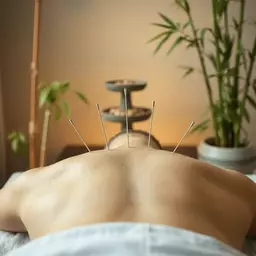China
Traditional Chinese Medicine (TCM), focusing on Qi and meridians, integrating herbs and dietary practices.
Subscribe to get the latest insights and updates straight to your inbox.
Posted on: 2025-03-12
By: Kaiya Whitmore
What if the key to holistic health lies in a practice that has thrived for thousands of years across various cultures? Acupuncture is more than just needle therapy; it's a bridge between ancient traditions and modern wellness solutions. By exploring its global significance, we uncover valuable insights that can transform our understanding of health.
Acupuncture practices differ significantly across cultures, reflecting unique adaptations to local health needs. Below is a visual representation of the various techniques employed around the world.
Traditional Chinese Medicine (TCM), focusing on Qi and meridians, integrating herbs and dietary practices.
Gentler techniques emphasizing minimal stimulation and patient comfort.
Unique methods like 'Saam' acupuncture, highlighting local traditions.
Blending traditional methods with evidence-based outcomes in modern healthcare.
Acupuncture is a fascinating subject that stretches far beyond its roots in ancient Chinese medicine. It has become a vital part of wellness practices around the world. At Acupuncture Perspectives, we delve into these global practices, exploring how this ancient technique is woven into modern health solutions.
Have you ever thought about how something as simple as a needle can have profound effects on your health? By understanding the various cultures' approaches to acupuncture, we can appreciate its significance and transformative power. Let's take a closer look at how acupuncture is not just a treatment—it's a bridge connecting different health traditions!
Acupuncture involves inserting thin needles into specific points on the body to promote healing and balance. But it's more than just a physical treatment; it’s a holistic approach that integrates mind, body, and spirit. Today, acupuncture is recognized worldwide as an effective therapy for a variety of conditions. For a deeper understanding of the benefits, explore our article on insights on acupuncture benefits.
In many cultures, acupuncture is celebrated for its ability to alleviate pain, reduce stress, and improve overall wellness. More than just a trend, it’s a testament to the global acceptance of holistic health practices. Here are a few key reasons why acupuncture has become significant worldwide:
When we think about acupuncture today, it’s essential to recognize its evolution. Traditionally rooted in Chinese culture, it’s now adapted in various forms globally. This evolution reflects a growing understanding and appreciation of alternative medicine, making it accessible to a broader audience.
At Acupuncture Perspectives, we are passionate about sharing the stories of those who have experienced the benefits of acupuncture. Each individual's journey, like that of Maya, who found relief from chronic migraines, showcases how acupuncture can fit into modern life and well-being.
The importance of acupuncture can’t be overstated—it serves as a vital link in the quest for holistic health. As people seek alternatives to conventional medicine, acupuncture provides a valuable option. It’s been integrated into wellness programs in hospitals, clinics, and even sports teams! This widespread acceptance signals a shift toward embracing diverse healing practices. To learn more about its role in Western medicine, read our article on acupuncture's role in Western medicine.
Moreover, the global fascination with acupuncture has led to increased research and interest in its applications. With growing evidence supporting its efficacy, acupuncture continues to gain recognition in medical circles, making it an essential topic for health enthusiasts and practitioners alike.
To fully appreciate acupuncture, it’s crucial to understand its foundational concepts. Two of these core ideas are *Qi (Chi)* and meridians, which form the basis of acupuncture theory. By exploring these concepts, we can grasp how acupuncture works to bring balance to our bodies. For a comprehensive understanding of these fundamentals, see our article on understanding acupuncture and Chinese medicine.
Are you curious about how energy flows through our bodies? Here are some key concepts to ponder:
Qi is often described as the life force that animates all living things. When Qi flows freely, we experience good health; when it’s blocked, issues arise. This concept is crucial in understanding how acupuncture aims to restore balance and promote healing.
Meridians, on the other hand, act as the pathways for Qi. They are interconnected and create a complex network throughout the body. By stimulating specific acupuncture points along these meridians, practitioners can influence the flow of Qi and target various health issues.
Acupuncture points are the focal areas where the needles are strategically inserted to help restore balance. Each point corresponds to a specific bodily function or organ system, making it essential for practitioners to have a deep understanding of their locations and applications.
At Acupuncture Perspectives, we emphasize the importance of tailored treatments. This personalized approach recognizes that each person is unique, requiring a customized plan to address their individual needs. By understanding the role of acupuncture points, practitioners can connect the dots between energy flow and overall wellness.
Here's a brief recap of the key points discussed so far:
Acupuncture is not a monolithic practice; it varies significantly across different cultures and regions. Understanding these global variations can provide insights into how this ancient technique adapts to meet the needs of diverse populations. As I delve into these distinct practices, I’m reminded of how Acupuncture Perspectives aims to showcase this rich diversity, allowing both practitioners and enthusiasts to appreciate the art of healing through the lens of local traditions.
Acupuncture techniques can often be categorized based on geographical and cultural influences. By examining these regional practices, we can see how acupuncture has evolved and integrated into various healthcare systems. Here’s an overview of some notable practices from around the world:
Let’s take a closer look at how acupuncture is practiced in specific regions. Each country has developed its own unique methodologies, enhancing the richness of acupuncture as a practice. In East Asia, the historical roots of acupuncture have shaped the way it is applied today.
In China, acupuncture is integral to TCM and is often used alongside herbal medicine, dietary recommendations, and therapeutic exercises. Conversely, in Japan, practitioners may utilize a technique called shakuju, which employs lighter needle insertion and a focus on patient comfort. This variation resonates well with those seeking a gentler approach!
As acupuncture spread to the West, it saw various adaptations that incorporated local healthcare practices. This evolution often aims to make acupuncture more accessible and relevant to a Western audience. For example, in many Western clinics, acupuncture is increasingly used in conjunction with physical therapy and rehabilitation programs.
Moreover, acupuncture is now often included in pain management protocols for conditions like chronic back pain or arthritis. This integration highlights the increasing recognition of acupuncture’s efficacy and its potential as a complementary treatment in modern medicine.
The relationship between acupuncture and traditional medicine is profound and multifaceted. In regions where traditional medicine plays a significant role, acupuncture is often viewed as a holistic approach to treating various health conditions.
Incorporating traditional practices, such as herbal medicine, can enhance the effectiveness of acupuncture treatments. By combining acupuncture with traditional herbs, practitioners create tailored approaches that address individual patient needs. I’ve seen firsthand how this integration enhances patient outcomes at Acupuncture Perspectives.
Exploring case studies from different regions can reveal the diverse applications of acupuncture. For instance, a practice in China may focus on balancing Qi to treat digestive issues, while a clinic in Japan may emphasize relaxation and stress relief for busy professionals.
These successful practices highlight the adaptability of acupuncture and its potential to resonate with various patient needs. By reflecting on these case studies, we can appreciate how acupuncture continues to evolve, enriching the lives of many. For more expert insights, check out our article on the benefits of acupuncture.
Here is a quick recap of the important points discussed in the article:

 Acupuncture, an ancient practice with roots in Traditional Chinese Medicine, has transcended cultura
Acupuncture, an ancient practice with roots in Traditional Chinese Medicine, has transcended cultura
 As the demand for alternative therapies grows, the need for well-trained acupuncturists becomes para
As the demand for alternative therapies grows, the need for well-trained acupuncturists becomes para
 As global health trends evolve, ancient practices like acupuncture are finding their place in modern
As global health trends evolve, ancient practices like acupuncture are finding their place in modern